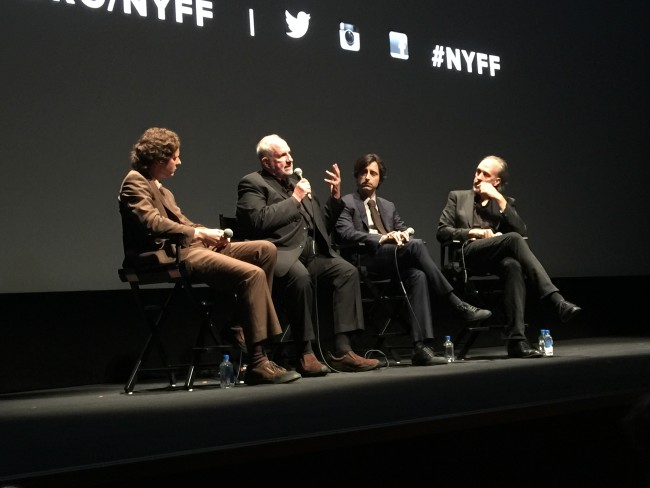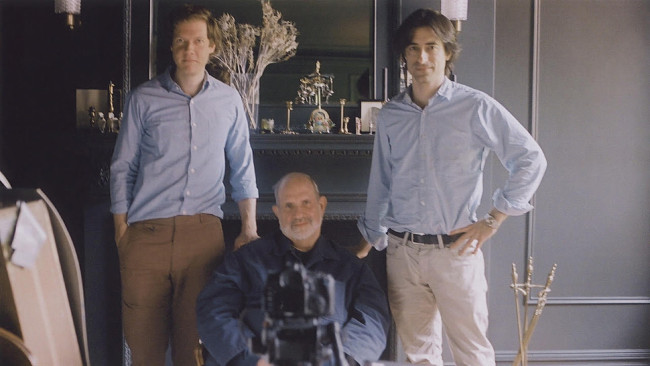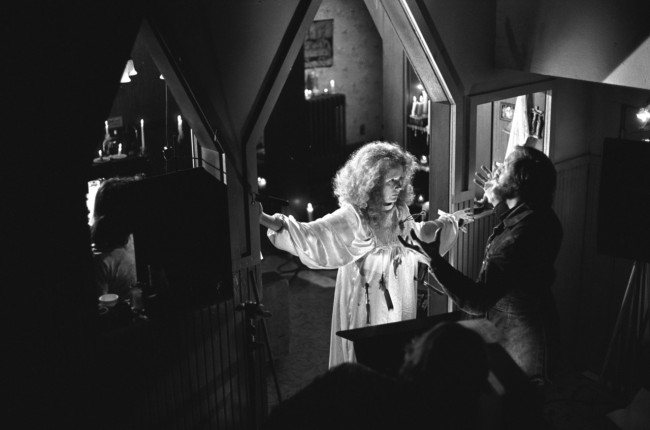By James Hancock September 30th, 2015
2015 is shaping up to be an astonishing year for documentaries on film. I already had the privilege of experiencing the ecstasy of Hitchcock/Truffaut (read my review here) and tonight the New York Film Festival gave me the chance to see De Palma, a fantastic new documentary from directors Noah Baumbach and Jake Paltrow. To my delight both the filmmakers and the subject of their film, Mr. Brian De Palma himself, were there in attendance. By a strange coincidence, the moderator of the Q&A was the director of Hitchcock/Truffaut, Kent Jones. Given De Palma’s reverence for the films of Hitchcock, the presence of Kent Jones felt very appropriate. Seeing De Palma in person was like seeing a god walk into the room. I’ve been a fan of De Palma since I was a kid before I had any idea who De Palma was or even what the hell a director does on a movie for that matter. De Palma has made so many movies where I’ve lost track of the number of times I’ve seen the films, movies like Carrie (1976), Scarface (1983), The Untouchables (1987), and Carlito’s Way (1993). Then there are his masterpieces like Dressed to Kill (1980), Blow Out (1981) and Body Double (1983) which grow in my estimation each time I see them. Of all the admirers of Alfred Hitchcock’s style of filmmaking, De Palma is his most impressive spiritual successor. De Palma is part of the pantheon of great directors that brought seismic changes to the film industry in the 1970s, a generation that includes Martin Scorsese, Francis Ford Coppola, George Lucas and Steven Spielberg. The fact that his best work is behind him does not diminish my respect for his filmography in the slightest. He is the first to admit that his career peaked creatively with Carlito’s Way and this documentary serves as an outstanding reminder of the decades of brilliant work he was responsible for in the 70s, 80s, & 90s. The film itself is pretty straight forward. De Palma makes the viewer feel as if he or she is sitting down to a private conversation with Brian De Palma where he is prepared to talk at length about anything the viewer wants to know. De Palma shows surprising skill as a raconteur as he describes the various challenges he’s faced over the years from handling difficult actors, developing screenplays, the best way to shoot a scene, and most importantly, how to navigate the politics of Hollywood while endeavoring to be an artist in an industry where vast sums of money are on the line. From universally despised flops like The Bonfire of the Vanities (1990) to massive hits like Mission: Impossible (1996), De Palma’s tales from the trenches will be an invaluable resource to filmmakers, both novices and veterans, for many years to come.
De Palma’s most important advice from my point of view was the value in building a network of fellow filmmakers both as professional comrades-in-arms and as personal friends who can understand the pain and torment most filmmakers will inevitably have to face. The best example of this at play was when De Palma and George Lucas teamed up to use the same casting calls for both Star Wars (1977) and Carrie (1976), a situation that worked to the advantage of both filmmakers. Now as an aging filmmaker, De Palma has thoroughly enjoyed developing relationships with the next generation of directors which is how this documentary eventually came to be made. What I loved most about the movie was De Palma’s brutal honesty about the realities of the film industry. De Palma has made so many movies both in and out of the studio system and each approach has its pitfalls to be avoided. On Phantom of the Paradise (1974), De Palma never bothered to get E&O insurance, consequently the film was hit with four massive lawsuits the moment they tried to distribute the film. While making The Bonfire of the Vanities, a high profile production adapted from Tom Wolfe’s bestselling book, De Palma was inundated with so many notes from studio execs the end result was a movie that appealed to no one, least of all De Palma who had originally believed it had the potential to be the greatest film of his career. Then there are the actors to deal with such as Cliff Robertson deliberately sabotaging takes for other actors on Obsession (1976) or Sean Penn provoking his costar Michael J. Fox by whispering ‘TV actor’ in his ear during a take on Casualties of War (1989). Mission: Impossible turned into an absurd scenario where De Palma had to play referee in a civil war of screenwriters with David Koepp writing drafts in one hotel room and Robert Towne, the studio’s choice, writing in another. Somehow out of the chaos, a hit movie emerged. Dressed to Kill and The Untouchables were two of the rare cases where both the shoot and the reception of the film could not have gone better. If these stories sound bleak, not to worry, De Palma smiles and laughs throughout all of his anecdotes, but there is nothing at all sentimental about De Palma’s frank descriptions of the movie biz. Filmmaking is a tough, brutal industry where nearly every day on the set can break a director, the film, or as he experienced on Mission to Mars (2000), both. De Palma sadly admitted that his filmmaking is pretty much over. He now has trouble walking and as challenging as the creative and political battles in filmmaking can be, the physical demands of being a director can often be the biggest challenge of them all.
One of the key takeaways from the film is how little control directors have over their own filmography. Contrary to the misconception of successful directors carefully picking their projects at just the right time, De Palma freely admits he often just had to go with projects that had a green light and were ready to go which is how he ended up directing Bruce Springsteen and the then unknown Courteney Cox in the music video ‘Dancing in the Dark’. There were times he would develop a screenplay for over a year like Prince of the City only to see it fall into the hands of another filmmaker like Sidney Lumet, a situation that was reversed when De Palma came on board Scarface, a film originally intended for Lumet. If there is one thing, however, that is consistent in his insanely unpredictable career, it is De Palma’s eye for framing a shot and staging action. One of his chief grievances against many directors is their inability to establish the geography of a scene leading to total confusion as the action begins to unfold. Whether he is filming a high school prank gone wrong in Carrie, his Odessa steps homage in The Untouchables, or the incredible chase through the subway in Carlito’s Way, few directors have ever managed to stage action in such a clear and powerful style quite like De Palma. But enough of my rambling. It is time for me to revisit some of De Palma’s classics and to see some of his earliest movies like Greetings (1968), The Wedding Party (1969) and Get to Know Your Rabbit (1972) for the first time. My obsession with De Palma has returned with a feverish intensity, an experience I imagine every fan of his, young and old, will have when they see this amazing documentary.
I am one of the Co-Hosts of Wrong Reel and you can find more of our content here:








